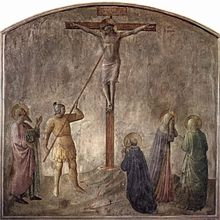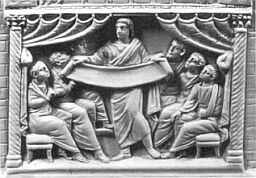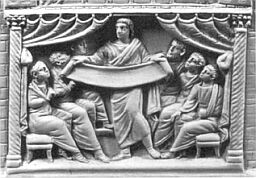Someone on a discussion list recently drew attention to how the Gospel of Luke changes the position of the call of the disciples to a period later than that found in the Gospel of Mark, so that it appears awkwardly out of place. Mark first describes Jesus calling Peter and others before going into Peter’s house to heal his mother-in-law. Luke, oddly, first has Jesus going into Peter’s house, and only afterwards calling him and others. It looks like Luke or some later redactor has got into a muddle and put the first meeting of Peter and Jesus AFTER Jesus visited Peter’s place.
Well having recently completed some notes and thoughts about canonical Luke being a possible redaction of an earlier gospel that may well have been closer in many respects to the gospel of Mark, I had to take a few minutes to see if there might be any particular redactional agenda for such a switch of order in events. Or was it just a consequence of clumsy editing? (I’m rolling with the general view that the author of Luke’s gospel knew and copied much from Mark’s gospel.)
We can’t know the latter author’s reasons for making the switch, but we can look at how the change functions in the narrative and see if that can suggest some clue about what the author might have been trying to do.
The Gospel of Mark’s sequence
Jesus starts his ministry in Capernaum
Jesus calls disciples
Jesus casts out a demon – his fame spreads
Jesus enters Peter’s house and heals Peter’s mother-in-law
Jesus heals many after sabbath
Many look for Jesus but Jesus leaves them behind
Apart from calling his disciples at the beginning of his ministry, there is little obvious narrative structural sequence to the events in Mark. It is episodic in the sense of just one thing after the other. I do think there is a structure that holds these episodes together in Mark, but it is not at the narrative level, and is another topic for another time. The most we can see here is that Jesus, logically, calls Peter for the first time before joining him in his house.
The Gospel of Luke’s sequence
Jesus begins his ministry in Nazareth
Jesus moves to Capernaum
Jesus casts out a demon – his fame spreads
Jesus enters Peter’s house and heals Peter’s mother-in-law
Jesus heals many after sabbath
Jesus is hindered by crowds as he teaches throughout Galilee
Crowds press upon Jesus by the lake and Jesus preaches to them
Jesus commissions his first disciples
Is it my imagination or is there really a sequential narrative development that I see here?
- Jesus begins his ministry in his home town. Result: he is cast out.
- He then moves to Capernaum. Result. a demon is cast out and Jesus’ fame spreads.
- After healing in Peter’s house, he heals many more after the sabbath.
- The crowds are so thick around Jesus he finds it hard to move anywhere.
- The crowds press on Jesus so he has to get into a boat to preach to them.
- Jesus then commissions his first disciples to “catch men”.
This looks very much like the sort of thing we read in Exodus and Acts. Crowds become too much for the prophet or apostle. Helpers are marshaled in response to the growing need for help given the escalating success of Jesus’ ministry. The author uses the same trope in Acts, such as when Barnabas enlisted Paul’s help because of the mass conversions at Antioch. (Talbert, p.63)
And Luke elsewhere repeats the theme of needing labourers for the spiritual harvest.
Talbert also observes that with Luke’s narrative the disciples are supplied with a reason to believe in Jesus and follow him. This can be seen in the passages below. In Mark, Jesus calls and the disciples mysteriously follow immediately. In Luke, Peter has already seen the power of Jesus’ word when he exorcised a demon with a command and healed Peter’s mother-in-law with a rebuke. (In Mark Jesus heals Peter’s mother-in-law without a word.) So when Peter is commanded to cast his net in the sea and he replies, “At your word I will do it”, it is plausibly to think that the reader is meant to understand that Peter already knows the power of Jesus’ word.
So despite the incongruity of Jesus appearing to enter Peter’s house before we appear to be told how the two met, there is a discernible narrative logic to the Lukan sequence. It may not feel complete. Where did Peter come from? Why is he mentioned without any explanation when he first appears? And in other areas too: Why does Jesus mention his deeds at Capernaum before he is said to have entered Capernaum? Nonetheless, there is a narrative logic overlaying the incongruities.
The Gospel of Mark’s calling
Now as he walked by the sea of Galilee, he saw Simon and Andrew his brother casting a net into the sea: for they were fishers.
And Jesus said unto them, Come ye after me, and I will make you to become fishers of men.
And straightway they forsook their nets, and followed him.
And when he had gone a little further thence, he saw James the son of Zebedee, and John his brother, who also were in the ship mending their nets.
And straightway he called them: and they left their father Zebedee in the ship with the hired servants, and went after him.
The Gospel of Luke’s commissioning
And it came to pass, that, as the people pressed upon him to hear the word of God, he stood by the lake of Gennesaret,
And saw two ships standing by the lake: but the fishermen were gone out of them, and were washing their nets.
And he entered into one of the ships, which was Simon’s, and prayed him that he would thrust out a little from the land. And he sat down, and taught the people out of the ship.
Now when he had left speaking, he said unto Simon, Launch out into the deep, and let down your nets for a draught.
And Simon answering said unto him, Master, we have toiled all the night, and have taken nothing: nevertheless at thy word I will let down the net.
And when they had this done, they inclosed a great multitude of fishes: and their net brake.
And they beckoned unto their partners, which were in the other ship, that they should come and help them. And they came, and filled both the ships, so that they began to sink.
When Simon Peter saw it, he fell down at Jesus’ knees, saying, Depart from me; for I am a sinful man, O Lord.
For he was astonished, and all that were with him, at the draught of the fishes which they had taken:
And so was also James, and John, the sons of Zebedee, which were partners with Simon. And Jesus said unto Simon, Fear not; from henceforth thou shalt catch men.
And when they had brought their ships to land, they forsook all, and followed him.
Comparing the two
Secondly, the Luke 5 lake scene is not a calling of the disciples as it is in Mark’s gospel. Canonical Luke does not narrate the calling of the disciples but their commissioning.
Compare Luke’s:
From now on you will catch men!
with the contingent Markan hope:
Follow me and I will make you fishers of men.
The idea in Luke of Jesus commissioning his disciples to help him is supported by the narrative logic already discussed. The crowds make the commissioning of the disciples, more than their calling in the hope they will succeed to the end, the real need.
There is also some ambiguity in the Markan passage about the meaning of being becoming fishers of men. If this is taken from Jeremiah 16:16 it could well be implying judgment, not salvation. But in Luke the theme of the crowds and the miracle of the fish-catch make it clear that the image means the converting of people to Christ.
This is further supported if one embraces the hypothesis that the author of canonical Luke knew John’s gospel and was blending John’s last chapter with the calling in Mark. John’s last chapter also depicts a miracle of an overwhelming catch of fish at the word of Jesus, and in that context it is clearly a metaphor for the conversions that Peter is expected to accomplish.
The theme of commissioning the disciples is elsewhere a prominent one in Luke’s gospel. The resurrected Jesus opens their understanding to the Jewish scriptures that were said to be prophetic of him, and he commands them to remain in Jerusalem until they are given heavenly power. They are confirmed as his witnesses. In Mark’s gospel, there is no certainty about the fate of the disciples at the conclusion, and in Matthew some of the disciples even doubted the resurrected Jesus.
Further, reflecting on the narrative logic above, this commissioning of the disciples arises directly out of the need for them to help with the spiritual harvest. It is the mushrooming crowds that make them a necessity. Calling to follow, with the possibility of failure, is not an option in Luke:
And the Lord said, Simon, Simon! Indeed Satan has asked for you, that he may sift you as wheat. But I have prayed for you, that your faith should not fail; and when you have returned to me, strengthen your brethren. (Luke 22:31-32)
By contrast it is readily possible to read the Gospel of Mark as concluding with the total failure of Jesus’ disciples. There is no resurrection appearance to them, and the narrative development has not encouraged the reader to expect them to follow Jesus at the end when or even if they hear he as gone on (again) before them. Like the seed in rocky soil they end their association with Jesus in fear, denial and betrayal.
Anti-Marcionite / proto-orthodox agenda?
Both these points combined — the need for the disciples on Jesus’ part, and the complementary commissioning of the disciples — are not found in Mark, yet they are consistent with canonical Luke’s interest elsewhere in establishing the authority of the disciples as commissioned witnesses and coworkers with and for Jesus. (See Luke’s resurrection chapter discussion.)
Canonical Luke can therefore be read as making changes to Mark’s gospel that reflect a program to strengthen the foundational place of the disciples in the Church. If so, this may be seen as one more of many other arguably anti-Marcionite agendas in canonical Luke-Acts. (See the Infancy Narratives discussion and the Body of Luke discussion.)
Like this:
Like Loading...





